By Grzegorz Krawczyk
The apricots and plums are in bloom while the peach buds are ready to burst as well. As the development of most insect pests is almost directly correlated to the outside temperatures and development of their host plants, this season's warm weather is likely to cause earlier than normal occurrence of fruit pests.
The flights of redbanded leafroller (Argyrotaenia velutinana) and spotted tentiform leafminer (Phyllonorycter blancardella) are about to start at any time as those two species overwinter as adults and the first few warm days usually initiates their flights. The next insect pest species also expected to start its flight is the Oriental fruit moth (OFM) Grapholita molesta, which usually starts its flight during the bloom of peaches.
To start capturing moths in the pheromone traps, insects have to complete their development (which is directly correlated with accumulated degree days) and the temperatures during the period of the day they normally use to fly need to be above their activity threshold. Only when both of these factors are achieved at the same time, can the moths start their seasonal activities and the first observed sustained captures in pheromone traps (biofix) can be observed. The examples of early spring OFM biofix dates in relation to the heat unit accumulation during the 2000 - 2015 seasons are presented in Figure 1.
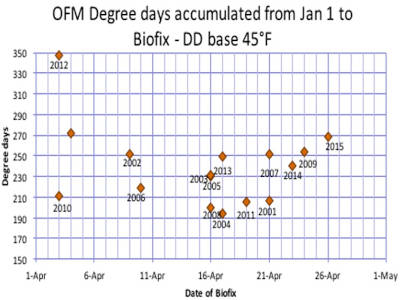
Figure 1. The occurrence of biofix dates as the correlation between accumulated degree days base 45°F and a field observed biofix events for the Oriental fruit moth during the 2000-2015 seasons. Penn State FREC 2020.
Using sex pheromone traps is the easiest method to accurately establish biofix for various pest species and to precisely monitor the trends in population development throughout the entire season. Establishing the correct biofix date for most important insect pests in fruit will help in better timing of management practices during the entire season and help to decide if these activities are justifiable.
At least two pheromone traps per species should be placed in the orchard before the expected start of the insect flight. And although the exact biofix dates fluctuate from year to year, the rule of thumb is to have OFM traps (Photo1) in the orchard by early April, traps for monitoring CM, lesser peachtree borer and tufted apple bud moth by the pink stage on apples, while traps for peachtree borer, dogwood borer, and obliquebanded leafroller no later than two weeks after the apple bloom. Traps for European apple sawfly should be present in the orchard during the bloom of apples. Our newest 2020-2021 Penn State Tree Fruit Production Guide provides all necessary info about traps placement, maintenance and sources for the lure and trap purchases (2020-2021 Penn State TFPG, pages 103-105).
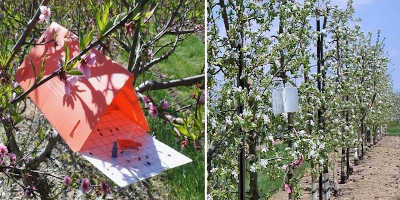
Photo 1. Pheromone traps for Oriental fruit moth (left) and European apple sawfly (right) in orchard. Photo: G. Krawczyk
Pear psylla update
Pear psylla (PP) adults are active and depositing first eggs on top of shoots in the pear block at the FREC in Biglerville (Photo 2). At least two applications of dormant oil should be applied before the bloom of pears to slow down the deposition of eggs and make the PP populations develop more uniformly throughout the rest of the season. An application of effective insecticide such as one of the pyrethroids before the white bud stage should also reduce the numbers of PP adults in the orchard. Unfortunately, if the pre-bloom applications of oil plus pyrethroid are not completed, at the petal fall all stages of pear psylla (i.e., eggs, nymphs, and adults) are present on infested trees.
An application of a product with active ingredient (AI) of abamectin (IRAC Group 6) in products such as Agri-Mek®, Agri-Flex® (mix with thiametoxam), Abba® or Abacus® remains one of the best PP control options at the petal fall stage to PF + 10 days, although lately we have seen in some cases lower than expected PP control efficacy with abamectin. A penetrating surfactant (i.e., a summer oil) is a necessary addition to Agri-Mek in order to provide the best PP control. Products such as Actara® (IRAC Group 4A), Centaur® (IRAC Group 4C), Delegate® (IRAC Group 5), Movento® (IRAC Group 23), Provado® (IRAC Group 4A), or Nexter® (IRAC Group21) also can be used at this time if additional control options are needed.
A change to the label of Rimon® with an active ingredient novaluron (IRAC Group 15) allows for use of this product on pears for PP control until the pear turn-down fruit stage. Another option for PP control is the use of kaolin clay, Surround®. If a good coverage with this product is maintained, Surround (applied at 25-50 lb/acre) represents an effective additional tool for the PP control. Surround residues on trees provide also good repellent against BMSB. In most orchards, multiple applications of Surround may be necessary to achieve good coverage effective against pear psylla.
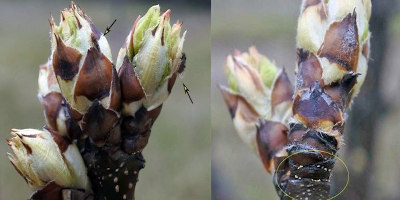
Photo 2. Pear psylla adults (left) and eggs (right) observed on pear trees on March 19, 2020. Photo: Greg Krawczyk, Penn State
Control of scale insects
San Jose scale (Quadraspidiotus perniciosus) overwinters as immature blackcaps on the trunks and scaffolds of the tree (Photo 3). The nymphs remain dormant under their waxy covering until the sap begins to flow in the spring, and they continue to feed until bloom. Scales are especially difficult to control on large trees with rough bark. Products containing chlorpyrifos (IRAC Group 1B) such as Chlorpyrifos®, Cobalt®, Cobalt Advanced®, Hatchet®, Lorsban®, Lorsban Advanced®, Nufos®, Warhawk®, and Yuma® are limited for use only to period no later than delayed dormant.
Other options to control scale after bud break but before the bloom include applications of oil, Centaur® (IRAC Group 16) or Esteem® (IRAC Group 7C). If the overwintering scales are not controlled during the pre-bloom period, the best time to effectively control the next generation scales will be around and after the second cover spray after the bloom. Application(s) of Esteem, Centaur or Movento® (IRAC Group 23) applied at that timing should help to manage this pest. The addition of oil will improve the efficacy of Centaur or Movento, while Esteem can be applied without oil.
To achieve the best efficacy of the above products, they should be used about two weeks after the start of San Jose scale (SJS) male flight. The flight of the SJS males can be monitored using pheromone traps (Photo 4). The after petal fall scale control activities should also be effective against white peach scale frequently observed in stone fruit orchards. Similarly to early-season mite control, the secret to good scale control is good coverage. Growers should use a minimum of 100 GPA or more depending on the size of their trees.
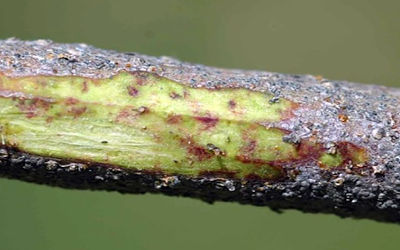
Photo 3A. San Jose scale injuries under the bark on a small apple twig. Photo: Greg Krawczyk, Penn State
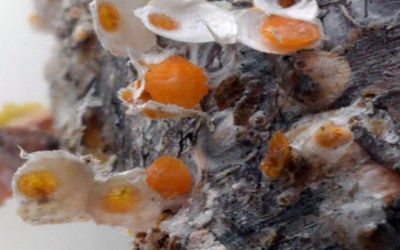
Photo 3B. Scale crawlers under microscope magnification. Photo Edwin H. Winzeler, Penn State

Photo 4. (Left) San Jose scale sex pheromone trap in the orchard; (Right) San Jose scale males captured on the sticky traps. Photos: Greg Krawczyk, Penn State
Protection of honey bees and wild pollinators
In order to maximize the protection of wild pollinators and honey bees, we continue to recommend avoidance of insecticide applications before the bloom. Although some insecticides are registered for the use just before bloom, with some registered for use up to the pink stage of apple trees, we recommend limiting the usage of insecticides after a delayed dormant period.
Most pest insects present in the orchard before the bloom period can also be effectively managed by the insecticide application(s) at the petal fall timing, which remains one of the most important treatments, setting the tone for the rest of the season.
In most situations, the insect pest complex present in orchards around bloom time such as; obliquebanded leafroller (OBLR), European apple sawfly (EAS), rosy apple aphid (RAA), Oriental fruit moth or plum curculio (PC), can be effectively controlled at and after petal fall.
Due to valid concerns with the possible pesticide direct and sub-lethal effects on the population of honey bees and other native pollinators (Photo 5) it is strongly recommended that growers refrain from using insecticides until bees are completely removed from orchards.
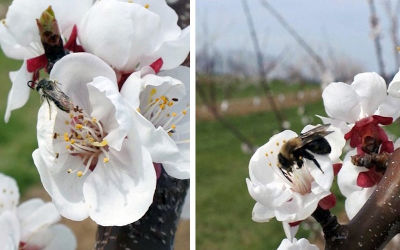
Source : psu.edu